Welcome to the ultimate guide for crafting your very own homemade vegetable broth. Forget the bland, overly salty store-bought versions; this recipe reveals how incredibly easy, significantly more affordable, and incomparably healthier it is to make your own. Vegetable broth isn’t just an ingredient; it’s a foundational staple, infusing countless dishes, from comforting everyday soups to elaborate Thanksgiving feasts, with an unparalleled depth of flavor and nutrition.

This guide has been carefully updated from its original publication to bring you the most comprehensive and user-friendly instructions for creating liquid gold in your kitchen.
Having a supply of this simple, wholesome vegetable broth on hand is a game-changer for any home cook. It’s absolutely essential for your Healthy Thanksgiving Recipes, providing a vibrant base for stuffings, gravies, and casseroles. Beyond holiday celebrations, you’ll find yourself reaching for it daily to enrich your favorite soup recipes, risottos, sauces, and countless other everyday dishes that call for a robust veggie stock.
Don’t let convenience tempt you into compromising on health or flavor. Crafting homemade vegetable stock is a straightforward process that yields a superior product to anything found on supermarket shelves. It’s not only healthier and less expensive but also incredibly versatile, allowing you to freeze it in various portion sizes, ensuring you always have exactly what you need at your fingertips.
Trust us, this truly is the best vegetable broth you’ll ever make. Once you experience the effortless preparation and taste the remarkable difference in health and flavor, those store-bought boxes will become a distant memory. We understand the allure of convenience; grabbing a carton of veggie stock from the pantry for a last-minute soup is undeniably appealing, especially on chilly evenings when dinner plans are non-existent.
However, the transition from store-bought to homemade is surprisingly seamless and profoundly rewarding. We’ve replaced that expensive and often unhealthy habit with a freezer full of homemade vegetable stock cubes, always ready to elevate our culinary creations.
Are you still relying on commercial bouillon cubes or powders? It’s worth pausing to consider their contents. Many commercial options are notorious for their sky-high sodium levels, often accompanied by MSG, inferior quality fats, artificial food colorings, and hydrolyzed soy or corn proteins. These additives are far from ideal for a healthy diet and can mask the true flavors of your cooking. Fortunately, creating a delicious, no-sodium vegetable broth from scratch is incredibly simple, and we’re here to show you how. For those moments when time is truly of the essence, our homemade vegetable bouillon powder recipe offers a super convenient alternative, transforming into flavorful broth in mere minutes.
What Exactly is Vegetable Broth?
At its core, vegetable broth is a flavorful liquid extracted by simmering fresh vegetables in water. As the vegetables gently cook, they release their natural sugars, minerals, and aromatic compounds into the liquid, creating a deeply nourishing and incredibly flavorful base for countless dishes. This golden elixir is often referred to as “liquid gold” by chefs and home cooks alike, and for good reason—it forms the backbone of risottos, gravies, stews, and, of course, a comforting bowl of soup. Unlike meat-based stocks, vegetable broth is naturally vegan and vegetarian-friendly, making it a versatile ingredient for diverse dietary needs. It’s a fundamental element in clean eating, allowing you to control every single ingredient that goes into your body.
Essential Ingredients for the Perfect Broth

- Onions: The aromatic cornerstone of any good broth. They contribute a sweet, savory depth. You can also use leeks for a milder, slightly sweeter note, or fennel for a delicate anise flavor.
- Carrots: These vibrant root vegetables are crucial for two reasons: they impart a natural sweetness that balances the savory elements and provide that beautiful golden hue characteristic of rich broth.
- Celery: Offering a fresh, subtly salty, and earthy flavor, celery is indispensable. Don’t discard the leaves; they are packed with flavor and should be added to your pot.
- Parsnips: Lending a distinct sweetness and an earthy, slightly nutty flavor, parsnips add complexity. Turnips or celeriac can be excellent substitutes, each offering a unique twist to the flavor profile.
- Parsley: Fresh parsley brings a bright, herbaceous, and earthy note that elevates the overall aroma and taste. While fresh is best, you could experiment with fresh thyme or oregano for a different aromatic character.
- Bay leaves: These dried leaves contribute a subtle, almost floral and savory depth that rounds out the flavors without overpowering them. Dried thyme can be a decent substitute, but a bay leaf offers that unique underlying complexity.
- Garlic: A few whole cloves of garlic provide a pungent, savory base. Chives or garlic scapes can be used as alternatives, offering a gentler garlic flavor.
- Peppercorns: Whole black peppercorns add a mild, earthy warmth. Since they are strained out, their flavor is subtle rather than spicy. Whole pink or white peppercorns can be substituted for a slightly different nuance.
Unleash Your Creativity: Broth Variations
While the basic recipe provides a versatile, neutral foundation, sometimes you might want a broth specifically tailored for a particular cuisine or dish. When making a large batch for general use and freezing, sticking to the traditional ingredients is best. However, if you have a specific culinary project in mind, feel free to infuse your basic vegetable stock with an assortment of other ingredients to create flavored broths:
- ASIAN-INSPIRED: Add fresh ginger slices, dried shiitake mushrooms (rehydrated), and scallion whites for a fragrant base perfect for ramen, stir-fries, or pho.
- MEXICAN-INSPIRED: Incorporate ripe tomatoes, a few jalapeños (or serranos for more heat), and fresh cilantro stems for a savory broth ideal for salsas, rice, or enchiladas.
- SWEET & EARTHY: Experiment with sweet potato, butternut squash, or even apples or pears for a slightly sweet, rich broth that pairs wonderfully with fall soups or savory-sweet glazes.
- OTHER ADDITIONS: Zucchini, summer squash, asparagus ends, and regular potatoes can all contribute to a general-purpose broth, adding subtle nuances.
INGREDIENTS TO AVOID: While many vegetables are wonderful in soups, some are less ideal for a basic, all-purpose broth due to their strong flavors or colors. Avoid strongly flavored cruciferous vegetables like cabbage, cauliflower, broccoli, and Brussels sprouts, as they can produce a bitter or overly pungent broth. Similarly, deeply colored vegetables like beets or purple carrots might yield a broth with an undesirable color. These vegetables are perfectly fine to add directly to a soup where the broth serves as the base, but they are not recommended for creating the foundational stock itself.
Need Veggie Broth in a Hurry?
Convenience doesn’t have to mean compromising on quality or health! Our vegan bouillon powder recipe is a fantastic alternative for those times you need instant broth. It uses simple, recognizable ingredients, gives you complete control over salt levels, boasts an impressive shelf life, and the best part: just add water, and you’ll have flavorful vegetable broth in about one minute!
Step-by-Step Guide: Crafting Your Own Vegetable Broth
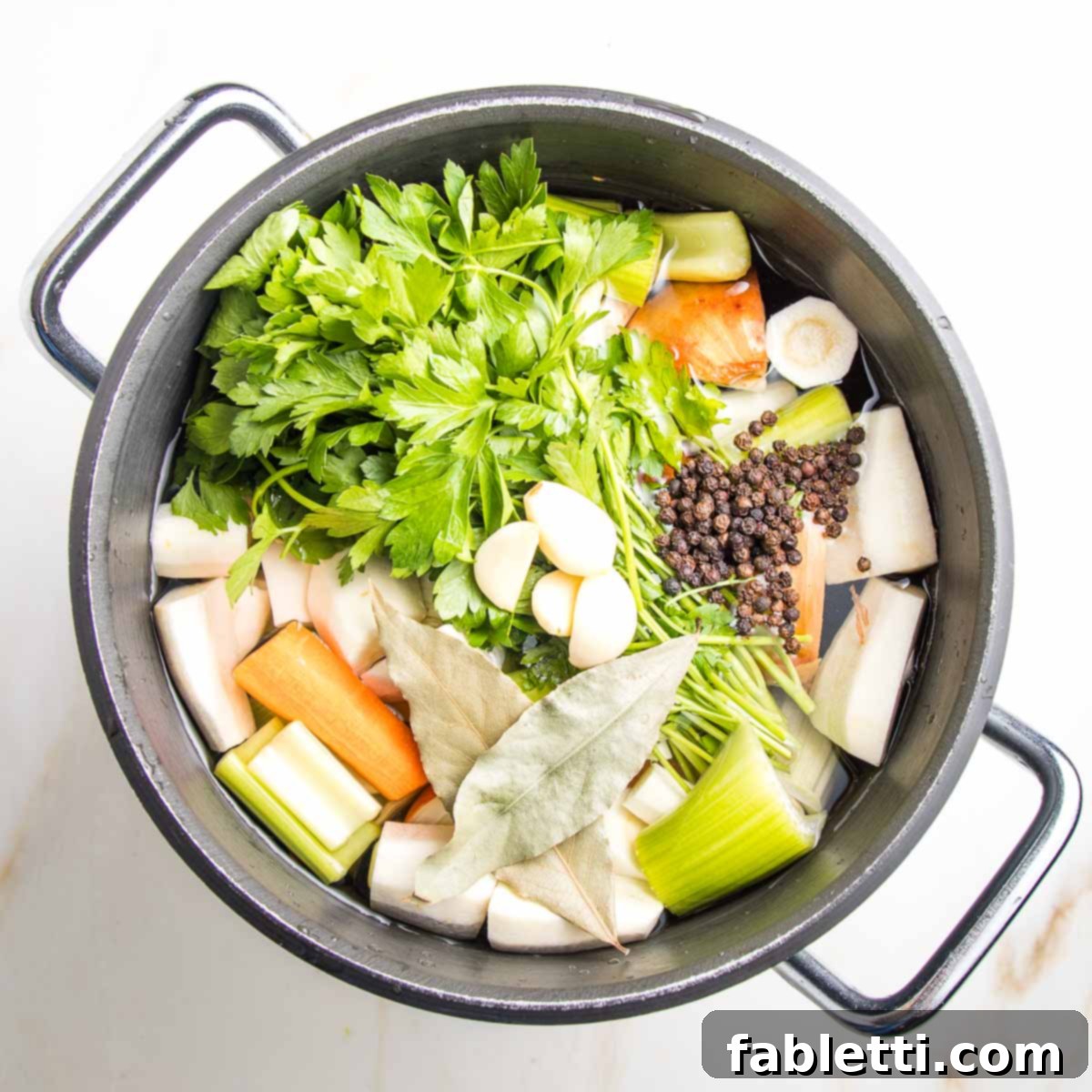
Start by gathering your chosen vegetables: quartered onions, roughly chopped carrots, parsnips, and celery. Don’t worry about perfect knife skills here; large, rustic pieces are ideal. Add a generous bunch of fresh parsley, a few whole cloves of garlic (peeled), a couple of bay leaves, and a handful of whole peppercorns into a large stock pot.
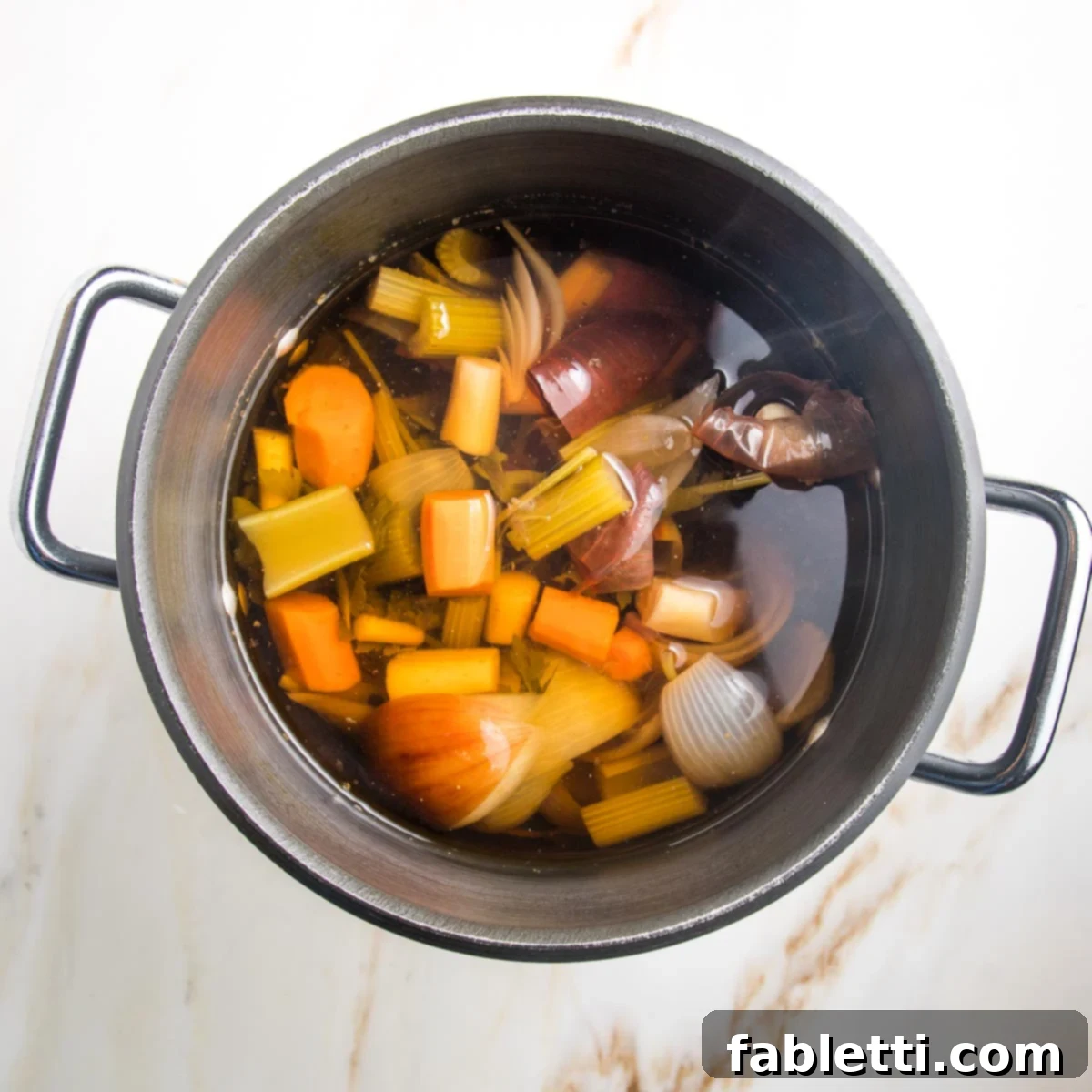
Cover all the ingredients generously with cold water and bring the pot to a rolling boil over medium-high heat. Once boiling, reduce the heat to a gentle simmer and let it cook, uncovered, for about 45 minutes to an hour. This allows the flavors and nutrients to fully extract into the liquid. Once simmered, carefully use a colander or a fine-mesh sieve to strain out all the cooked vegetables, leaving behind a clear, fragrant broth. All the delicious essence and goodness will be concentrated in your liquid gold. Allow the broth to cool completely before transferring it to storage containers.
The spent vegetables can be added to your compost bin, returning their goodness to the earth. Alternatively, if you desire a creamy, hearty soup, you can remove the bay leaves, peppercorns, and parsley stems, then puree the remaining cooked vegetables. Stir this puree back into your strained broth, mix thoroughly, and season with a pinch of salt if desired. This makes for a wonderfully nourishing, satisfying, and delicious meal in itself.
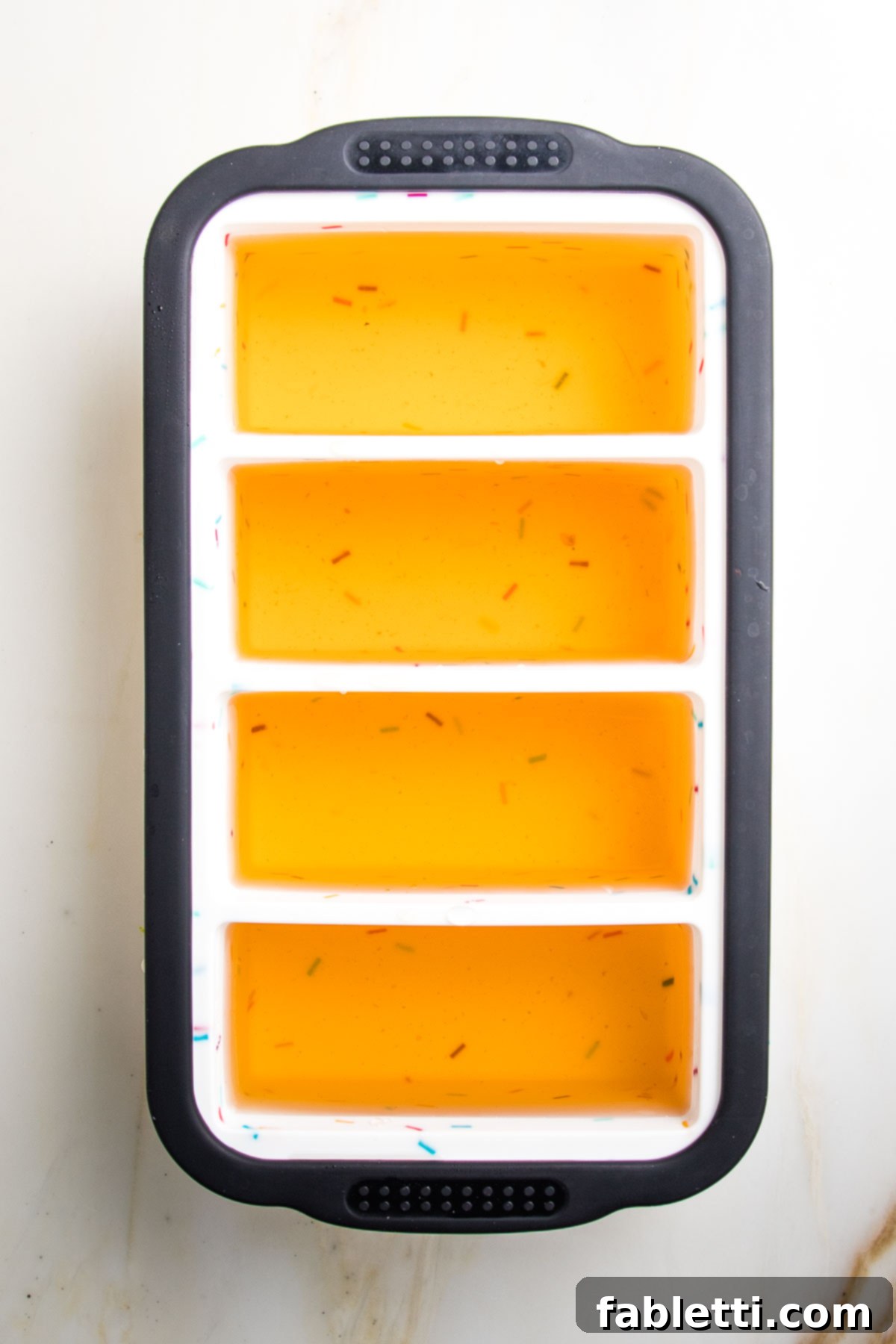
Freezing vegetable broth in convenient 1-cup portions is highly recommended. We utilize silicone molds of various sizes to accommodate future cooking needs. Once frozen solid, these broth cubes can be easily transferred to freezer-safe zip-top bags. This method offers incredibly convenient storage, taking up minimal space in your freezer while providing instant access to perfectly portioned broth whenever a recipe calls for it.
Homemade vs. Store-Bought: The Undeniable Advantages
- Budget-Friendly: One of the most compelling reasons to make your own vegetable broth is the cost savings. You can easily make three quarts (the equivalent of three store-bought cartons) for a fraction of the price of buying just one. This makes homemade broth a smart choice for any budget-conscious kitchen.
- Rich and Flavorful: When you use whole, fresh, real food ingredients, the taste is simply incomparable. There’s no need for artificial flavor enhancers or hidden additives; the natural essences of the vegetables shine through. You have complete control to adjust the ingredients to your preference, adding more of what you love, and even simmering it longer to create a highly concentrated, richer flavor if desired.
- Nourishing & Clean: Homemade broth means absolutely no undesirable additives like MSG, artificial preservatives, processed vegetable oils, or excessive salt. You know exactly what’s in your soup base, making it a pure and wholesome choice. Furthermore, it’s easily adaptable to specific dietary needs; for example, if you’re on a low-FODMAP diet, you can simply omit problematic ingredients and increase the quantities of others.
- Unmatched Convenience (Yes, Really!): This might seem counter-intuitive, but homemade broth is ultimately more convenient than store-bought. When you make a batch from scratch, you dictate the storage method to perfectly suit your lifestyle. If a particular recipe consistently requires six cups, freeze it in six-cup increments. For oil-free cooking where you just need a splash to prevent sticking, freeze small portions in regular ice cube trays. This eliminates waste and ensures you pull out precisely the amount you need, whenever you need it.
- No Sodium Control: Finding genuinely no-sodium vegetable broth in stores is a challenge. For those on a low-sodium diet or simply aiming to control their salt intake, homemade vegetable stock is a game-changer. You can prepare a truly no-salt vegetable broth, allowing you to season your dishes precisely to your taste.
Broth vs. Stock: Decoding the Culinary Terms
The terms “vegetable stock” and “vegetable broth” are often used interchangeably in home kitchens, and for most recipes, you can indeed substitute one for the other without issue. In fact, we often use both terms throughout our recipes to reinforce this flexibility. Traditionally, the primary distinction between stock and broth lies in the use of bones in stock (animal bones, that is) and the level of seasoning. However, when it comes to vegan varieties, these differences become much more subtle. Here are a few key takeaways to consider:
- Seasoning: Broth is typically seasoned, often with salt, during its cooking process. Stock, on the other hand, is generally unseasoned, providing a neutral base to be seasoned later in a dish. This is where the concept of “no-salt” homemade broth becomes especially relevant.
- Purpose: Broth is often considered something you can sip on its own, a comforting beverage. Stock is almost exclusively intended for use as a cooking ingredient, forming the base of other recipes.
- “Purist” View: Many culinary purists argue that for vegan preparations, there’s virtually no practical difference between stock and broth, as the main defining factor (animal bones) is absent.
Ultimately, we encourage you to focus on the process: simmer a pot of fresh vegetables, strain the flavorful liquid, and confidently use it for any recipe that calls for either vegetable stock or broth. The result will be equally delicious and versatile.
Expert Tips for Broth Mastery
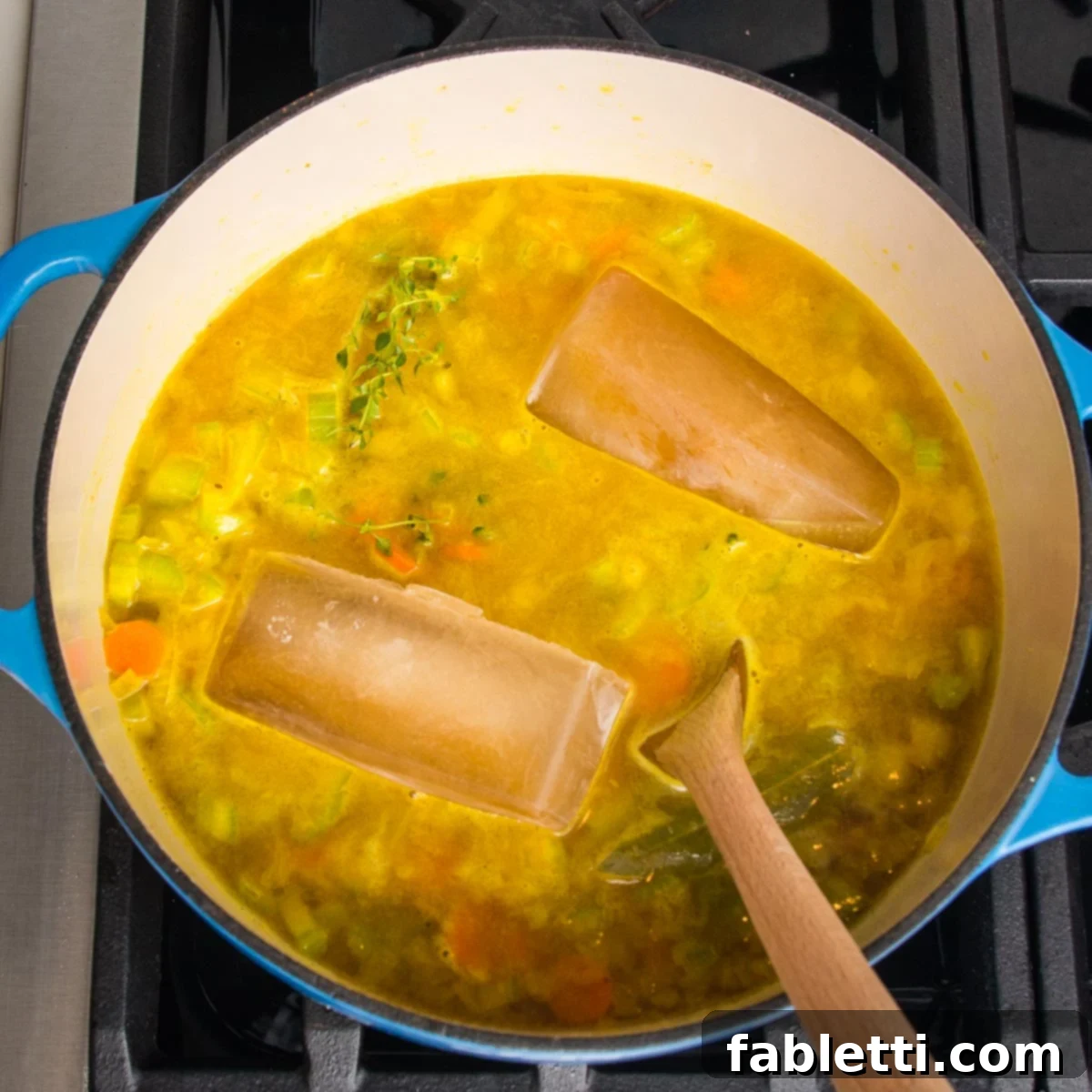
- Utilize Vegetable Scraps: Become a waste-reducing chef! Keep a designated bag in your freezer for vegetable scraps. As you trim carrots, onions, celery, mushrooms, and fresh herbs, toss the clean trimmings and peels (that would otherwise go into compost) into this freezer bag. When it’s time to make broth, add these accumulated scraps to your pot for an extra layer of complex flavor.
- Freeze in Various Sizes: Optimize your convenience by freezing broth in different sized containers. This includes regular ice cube trays for small amounts (perfect for deglazing a pan or adding a touch of moisture) and larger silicone molds (like Souper Cubes) for 1-cup or 2-cup portions. Once frozen, pop the cubes into freezer-safe zip-top bags for space-efficient storage.
- Directly from Freezer to Pot: Don’t bother thawing your veggie broth cubes beforehand. Simply drop them directly from the freezer into your simmering pot of soup, stew, or sauce. They will defrost quickly and melt seamlessly into your dish, adding instant flavor.
- Choose Quality Freezer Bags: If using zip-top bags for storage, ensure they are specifically labeled as “freezer grade” to prevent freezer burn and maintain the broth’s quality.
- Allow for Expansion: Remember that liquids expand when frozen. If you’re freezing broth in glass jars, leave at least an inch of headspace at the top to prevent the glass from cracking.
- Adjust Seasoning Thoughtfully: If you’re accustomed to store-bought stock, you’re also likely used to a high sodium content. Give your palate time to adjust to the clean, nuanced taste of no-salt homemade vegetable broth. When using your unsalted broth in recipes, keep in mind that recipes typically assume the broth is already salted. Always taste your final dish and adjust seasonings accordingly, adding salt as needed to achieve perfect balance.
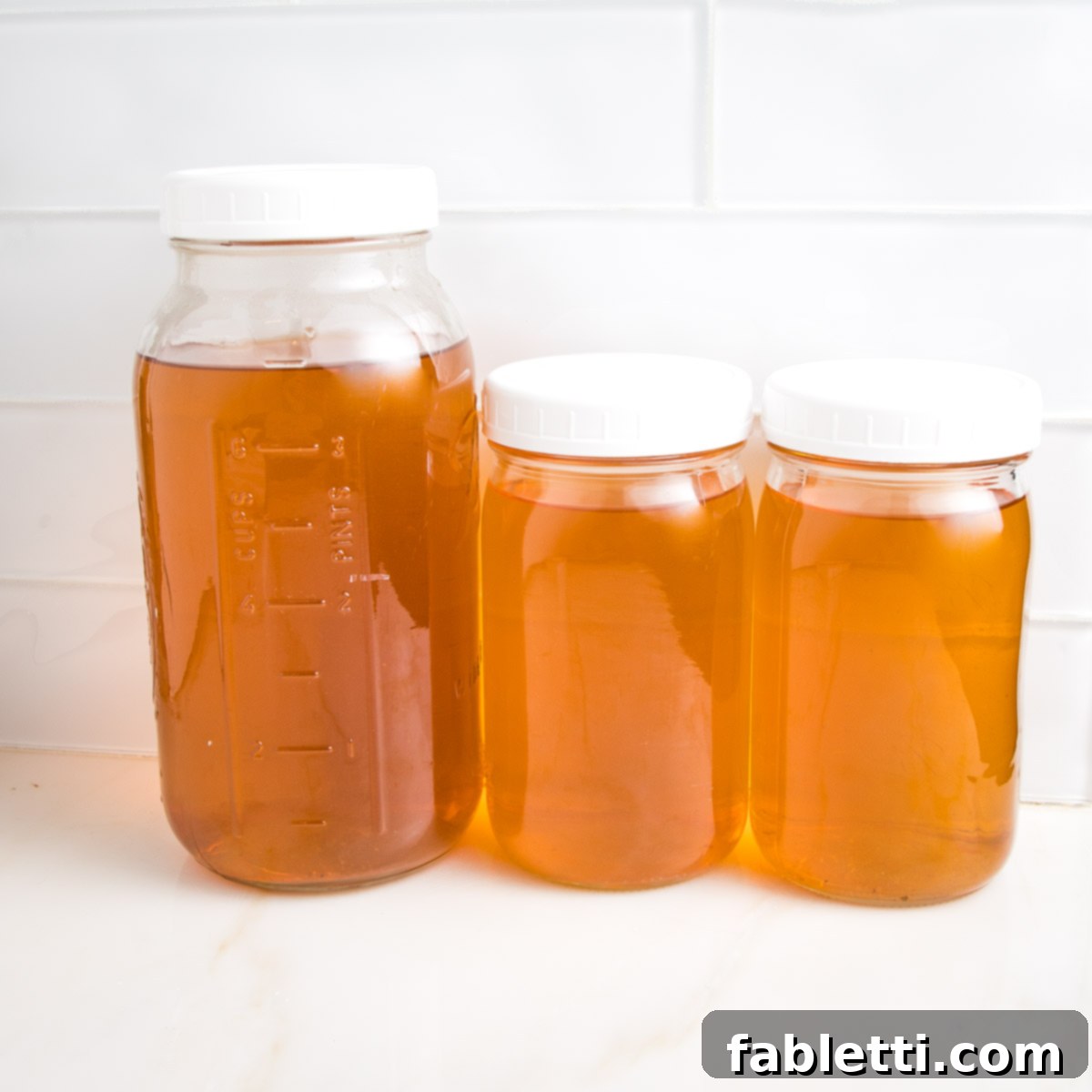
Recipes That Flourish with Homemade Vegetable Broth
Your freshly made vegetable broth is a versatile base that can elevate a wide array of dishes. Here are some fantastic recipes where your homemade liquid gold will truly shine, adding unparalleled depth and flavor:
- Vegan Mushroom Stroganoff Recipe
- Easy Vegan Gravy Recipe
- Homemade Red Enchilada Sauce
- Gluten-free Cornbread Stuffing
Your engagement helps food bloggers thrive! If you’ve enjoyed making this recipe, please consider leaving a five-star rating and a comment below. We also encourage you to share your culinary creations on Instagram by tagging @dkhealthcoach and using the hashtag #debraklein so we can celebrate your success!
📖 Recipe

Vegetable Stock
Debra Klein
Rate this Recipe
Pin Recipe
5 minutes
45 minutes
50 minutes
Soup
American
3
quarts
34
kcal
Equipment
- Souper Cubes Silicone Freezer Tray
- Stainless Steel Stock Pot/Stockpot
Ingredients
-
2
onions -
4
large carrots -
3
parsnips -
3
stalks celery -
4
cloves
garlic
peeled -
1
bunch parsley -
2
bay leaves -
1
Tablespoon
peppercorns -
5
quarts
water
Instructions
- PREPARE THE VEGGIES: As you prepare each vegetable, add it directly to a large stock pot. Quarter the onions, optionally leaving the skins on for a more intensely colored broth. Peel or simply scrub the carrots and parsnips, then roughly chop them; large pieces are perfectly fine. Clean and trim the celery before roughly chopping. Peel the garlic cloves, but leave them whole. Rinse the parsley thoroughly, keeping the stems intact.
- Pour in 5 quarts (approximately 20 cups) of filtered water, ensuring it more than covers all the vegetables. Add the bay leaves and whole peppercorns.
- Over medium-high heat, bring the mixture to a full boil. Once boiling, reduce the heat to a gentle simmer and let it cook, uncovered, for 45 minutes to an hour.
- Carefully strain the broth, discarding the cooked vegetables or setting them aside for an alternative use as mentioned above.
- Allow the veggie stock to cool completely to room temperature before transferring it into covered containers. It will keep well in the refrigerator for up to a week.
- For longer storage, freeze the broth in quart-sized containers for easy access when preparing a large pot of soup. Alternatively, use ice cube trays for smaller portions (once frozen, pop the cubes into zip-top bags). These small frozen cubes are perfect for quickly defrosting small amounts when a pan needs a little moisture, eliminating the need for additional oil. Stock can be stored in the freezer for up to 3 months.
Notes
Nutrition
Serving:
1
cup
Calories:
34
kcal
Carbohydrates:
8
g
Protein:
1
g
Sodium:
36
mg
Fiber:
2
g
Sugar:
3
g
Note
The nutrition calculations were done using online tools. To obtain the most accurate representation of the nutritional information in any given recipe, you should calculate the nutritional information with the actual ingredients you used. You are ultimately responsible for ensuring that any nutritional information is accurate, complete and useful.
Did you make this recipe?
Please leave a review below, then snap a picture and tag me @dkhealthcoach or use hashtag #dkhealtcoach on Instagram so I can see it!!
